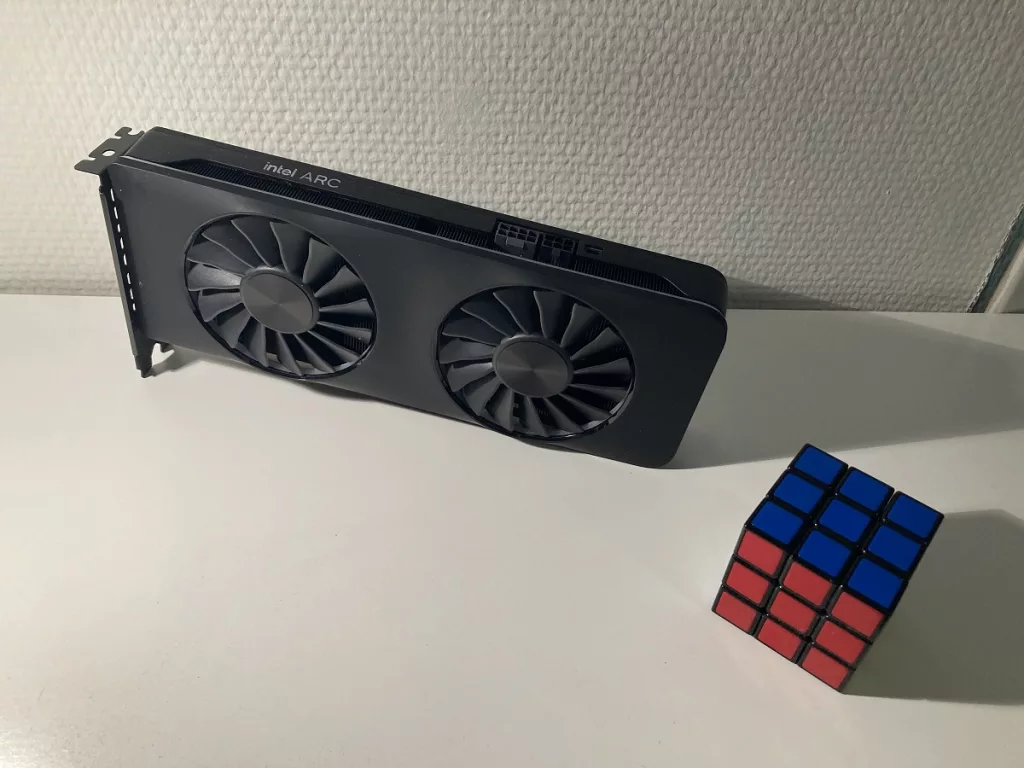Why Is Intel Arc So Cheap? A Professional Analysis

Intel Arc is a new line of graphics cards that has recently entered the market. One of the most striking features of these GPUs is their affordability. Compared to their competitors, the Intel Arc GPUs are significantly cheaper. This has led many to wonder why these graphics cards are so affordable.
One reason for the low price of Intel Arc GPUs is that they are aimed at the mid-range market. While high-end GPUs from competitors such as Nvidia and AMD can cost upwards of $1,000, the Intel Arc GPUs are priced much more modestly. This is because Intel is targeting a different market segment than its competitors. By focusing on the mid-range market, Intel can offer a more affordable product that is still competitive in terms of performance.
Another reason for the low price of Intel Arc GPUs is that they are based on a new architecture that is designed to be more cost-effective. The Alchemist architecture, which is used in the Intel Arc GPUs, is optimized for performance per watt. This means that the GPUs are more power-efficient than their competitors, which reduces the cost of producing them. Additionally, Intel has made use of its own manufacturing facilities to produce the GPUs, which has helped to keep costs down.
Intel Arc’s Market Positioning
Intel Arc’s market positioning is focused on affordability, targeting gamers who want a decent graphics card without breaking the bank. The company aims to compete with Nvidia and AMD by offering a lower-priced alternative.
Intel’s first desktop gaming graphics cards, the Arc Alchemist, were launched in October 2022. The Arc Alchemist is available in three models: the Arc 5, Arc 6, and Arc 7. The Arc 5 is the entry-level model, while the Arc 7 is the high-end model.
One reason why Intel Arc is priced lower than its competitors is that the company is new to the GPU market and is still trying to establish itself. Intel is aware that it needs to offer an attractive price point to gain market share and attract customers.
Another reason why Intel Arc is cheaper is that the company is not trying to compete with Nvidia and AMD’s high-end graphics cards. Instead, Intel is targeting the mid-range market, which is less expensive and less competitive.
Intel Arc’s pricing strategy is also influenced by the fact that it is using TSMC’s 6nm manufacturing process, which is cheaper than the 7nm process used by Nvidia and AMD. This allows Intel to offer lower-priced graphics cards without sacrificing performance.
Overall, Intel Arc’s market positioning is focused on affordability, targeting mid-range gamers who want a decent graphics card without breaking the bank. The company’s pricing strategy is influenced by its newness to the market, its focus on the mid-range market, and its use of a cheaper manufacturing process.
Cost-Effective Manufacturing Process
Intel’s new Arc GPUs have been making headlines for their affordable pricing, but how is the company able to offer such competitive prices? The answer lies in their cost-effective manufacturing process.
Efficient Chip Design
Intel’s Arc GPUs are built on their new Alchemist architecture, which was designed from the ground up with efficiency in mind. The architecture is optimized for performance and power consumption, allowing Intel to use smaller and more cost-effective manufacturing processes without sacrificing performance.
In addition, Intel has implemented a modular design approach for their Alchemist GPUs, which allows them to reuse components across different products. This reduces the amount of time and resources required to design and manufacture new products, further reducing costs.
Economies of Scale
Another key factor in Intel’s cost-effective manufacturing process is economies of scale. By outsourcing the manufacturing of their Arc GPUs to TSMC, Intel is able to take advantage of TSMC’s massive manufacturing capabilities and benefit from their economies of scale.
TSMC’s advanced manufacturing processes allow for higher yields and better performance, while also reducing costs. By leveraging TSMC’s expertise and manufacturing capabilities, Intel is able to produce their Arc GPUs at a lower cost than if they were to manufacture them in-house.
Overall, Intel’s cost-effective manufacturing process is a result of their efficient chip design and the economies of scale provided by outsourcing to TSMC. By optimizing their design and leveraging TSMC’s manufacturing capabilities, Intel is able to offer their Arc GPUs at an affordable price without sacrificing performance.
Strategic Pricing Strategy
Intel’s Arc graphics card line has been priced aggressively, with the top-end Arc Alchemist A790 512EU variant rumored to be priced at $999. This pricing strategy is part of Intel’s broader plan to gain market share in the highly competitive GPU market.
Competitive Market Scenario
The graphics card market is dominated by two major players, Nvidia and AMD. These two companies have a stranglehold on the market, with Nvidia holding a 70% market share and AMD holding a 30% market share. This duopoly has made it difficult for new players to enter the market.
Intel’s entry into the market with its Arc graphics card line is seen as a direct challenge to Nvidia and AMD’s dominance. To compete, Intel has adopted a strategic pricing strategy that undercuts its competitors. By offering high-end GPUs at a lower price point, Intel hopes to gain market share and establish itself as a viable alternative to Nvidia and AMD.
Customer Acquisition Approach
In addition to its pricing strategy, Intel is also taking a customer acquisition approach to gain market share. The company is targeting gamers and content creators, two demographics that are known for being early adopters of new technology.
To appeal to these audiences, Intel is focusing on the performance and features of its Arc graphics cards. The company is emphasizing the high clock speeds, ray tracing capabilities, and AI acceleration of its GPUs. By offering a superior product at a lower price point, Intel hopes to win over customers and establish itself as a major player in the graphics card market.
Overall, Intel’s strategic pricing strategy and customer acquisition approach are part of a broader plan to gain market share in the highly competitive graphics card market. By offering high-end GPUs at a lower price point and targeting key demographics, Intel hopes to establish itself as a viable alternative to the dominant players in the market.
Technology and Performance
Intel Arc is a new line of graphics cards that has been making headlines for its affordability. While the price is a major factor, it’s important to examine the technology and performance behind the Arc GPUs to understand why they are so cheap.
Performance per Dollar
One of the key factors that make Intel Arc so affordable is its performance per dollar ratio. Intel has optimized the Arc GPUs to deliver a high level of performance at a lower price point. According to Intel’s own data, the Arc GPUs offer better performance than their direct competitor, Nvidia’s RTX 3060.
Intel Arc’s A750 has been pitted against the RTX 3060, and the results show that the A750 outperforms the RTX 3060 in several games. In some cases, the A750 offers up to 20% better performance than the RTX 3060. This performance advantage is particularly impressive considering the A750 is priced significantly lower than the RTX 3060.
In addition to the A750, Intel’s flagship Arc A770 and A380 GPUs also offer excellent performance per dollar. The A770 is available in 16GB and 8GB variants and has been optimized for 4K gaming. The A380, on the other hand, is a mid-range GPU that offers excellent performance for its price point.
Overall, Intel has managed to deliver excellent performance per dollar with its Arc GPUs. By optimizing the technology and focusing on delivering value to consumers, Intel has created a line of graphics cards that is both affordable and powerful.
Future Implications
Potential Market Disruption
The affordability of Intel Arc GPUs could potentially disrupt the market and challenge the dominance of Nvidia and AMD. As the most powerful GPU in the Arc line, the Arc A770 is priced at only $329, which is significantly lower than the prices of comparable GPUs from Nvidia and AMD.
If Intel continues to focus on affordability, it could attract budget-conscious gamers who are not willing to spend a lot of money on high-end GPUs. This could lead to a shift in market share and force Nvidia and AMD to adjust their pricing strategies to remain competitive.
Long-Term Sustainability
While the affordability of Intel Arc GPUs could be a selling point in the short term, it remains to be seen whether it is sustainable in the long run. The development of GPUs is a costly and time-consuming process, and Intel has already spent $2.1 billion on the Arc project.
If Intel continues to sell GPUs at low prices, it may struggle to recoup its investment and turn a profit. This could lead to a situation where Intel is forced to abandon the Arc project altogether, which could be a blow to the company’s reputation and credibility in the GPU market.
Furthermore, the long-term sustainability of the Arc project also depends on the quality and performance of the GPUs. If the GPUs fail to meet the expectations of gamers, it could lead to a loss of confidence in the brand and hurt Intel’s reputation in the gaming community.
In conclusion, the affordability of Intel Arc GPUs has the potential to disrupt the market and challenge the dominance of Nvidia and AMD. However, the long-term sustainability of the project remains uncertain and will depend on factors such as pricing strategies, quality and performance, and market demand.
Frequently Asked Questions
What are the key features of Intel Arc GPUs?
Intel Arc GPUs are designed for high-performance gaming and content creation. They feature a new microarchitecture that enables faster processing and improved efficiency. Intel Arc GPUs also include a groundbreaking media engine and Intel Deep Link technology for faster encoding and streaming.
How does the performance of Intel Arc GPUs compare to Nvidia GPUs?
In benchmark tests, Intel Arc GPUs have shown comparable performance to Nvidia GPUs in their respective price ranges. While Nvidia still holds the top spot in the high-end market, Intel Arc GPUs offer a competitive option for mid-range users.
What is the price range of Intel Arc GPUs?
The price range of Intel Arc GPUs varies depending on the model and specifications. The flagship Arc A770 is available in 16GB and 8GB variants and is priced competitively with similar offerings from Nvidia and AMD. The Arc A750 and A380 are also available at lower price points.
What are the benchmarks for Intel Arc A770?
The Intel Arc A770 has been benchmarked against the Nvidia GeForce RTX 3080 and has shown comparable performance in gaming and content creation tasks. The A770 also features hardware-accelerated ray tracing and AI-based super sampling for improved visuals and performance.
Is it worth buying an Intel Arc GPU?
Whether or not an Intel Arc GPU is worth buying depends on individual needs and preferences. For mid-range users looking for a competitive option, the Intel Arc GPUs offer a solid choice. However, for high-end users or those looking for specific features, Nvidia and AMD may still be the better option.
What led to the failure of Intel Arc’s previous attempts at GPUs?
Intel has had previous attempts at entering the GPU market, but they were met with limited success. One reason for this was a lack of focus on the gaming market, which is the primary target for the Intel Arc GPUs. Additionally, previous attempts were hindered by manufacturing issues and delays.







